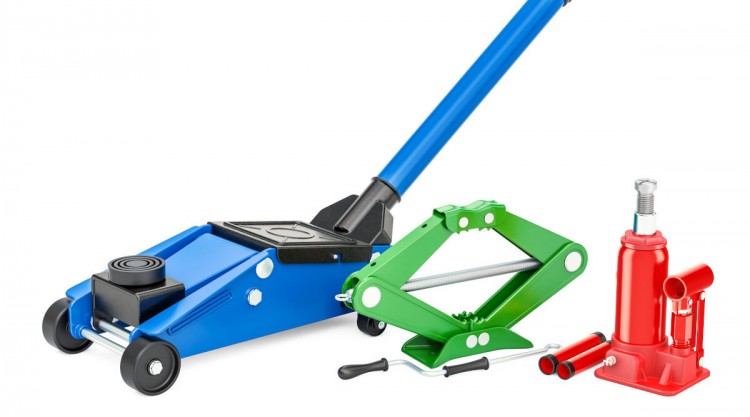
In this guide, we take a look at the many different types of car jacks, how they work, what each type is best suited to, and ultimately which type you should buy to suit your particular needs.
Last Updated: January 4, 2023

To draw a very loose parallel, having jacks in your garage is kind of like having jacks in euchre. Any jack is a good jack, but if you’ve got the right ones, they’ll trump everything else you’ve got in your hand.
OK, so that’s a bit of a stretch for a metaphor. But there’s no denying the value of having a good jack in your garage. This goes for any vehicle owner, whether you’re an ace mechanic, a weekend tinkerer, or a complete novice with all things automotive.
But as you’ve probably already figured out, there are many types of jacks on the market. Even within a single category of jack, there are tons of options to choose from. How are you supposed to know what the best choice for your needs – and your money – is?
The answer is simple – read this article!
We’re going to explain how all types of car jacks work, their relative pros and cons, and why you might want to own a particular kind. Read on to learn what the right jack is for you!
First, the basics. A car jack is any mechanical device used for lifting a vehicle partially or entirely off the ground.
Why would you want to do this? There are many possibilities, including:
No matter your level of expertise, there are plenty of good reasons (and excuses!) to jack up your vehicle.
There are two basic types of car jack: mechanical and hydraulic. Here’s a quick overview of both.
Jacks that fall under this category use purely mechanical methods of creating lift.
This may mean using a screw to raise and lower a hinged mechanism incrementally or using a ratcheting system to lift a vehicle a notch at a time slowly. Included in this category are your basic scissor jack, and the savior of many an off-roader, the high lift jack.
These types of jacks use either a horizontally or vertically mounted hydraulic cylinder to lift large objects.
How do hydraulics work? Without going too deep into the physics, basically a hydraulic system takes advantage of the fact it is really difficult to compress a fluid.
The jack has a reservoir full of a sort of oil. On the upstroke of the handle, some of that oil is pulled from the reservoir. On the downstroke, that portion of the oil is forced into the central cylinder and underneath a piston. As the amount of fluid under the piston increases, the pressure (which keeps building because the oil won’t compress) pushes the cylinder up. It will stay up until the oil is let out and flows back into the reservoir.
The most common type of hydraulic jacks are bottle jacks and floor jacks.
Now that you know the two basic systems employed by car jacks, let’s take a look at each of the four types individually.
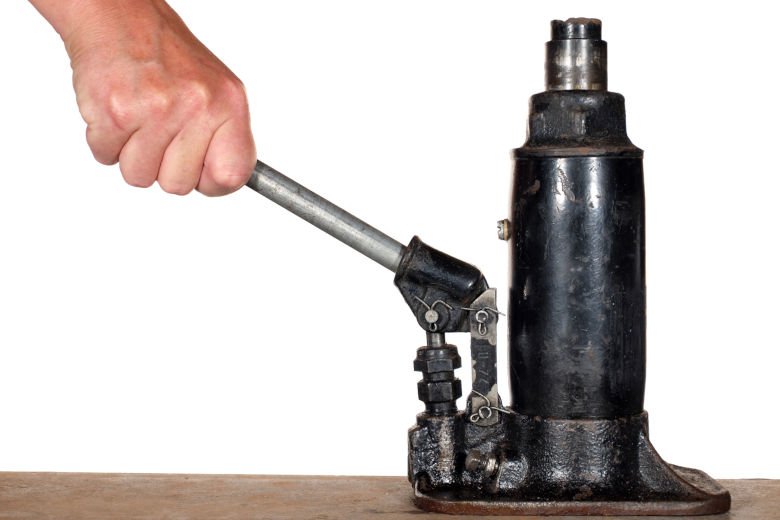
One of the most commonly owned types of jacks, they’re also perhaps the most versatile. Using a vertical hydraulic cylinder, the operator just has to pump the handle up and down to lift a large vehicle with ease.
Many of the best models have a wide base for extra stability. Most will even function on their sides. (You’ll never lift a car this way, but it can be useful for pushing heavy items or even bending metal bars. A must-have for any prison break!) You’ll often see this type of jack used on construction sites for supporting foundations or floor joists.
Typically, hydraulic bottle jacks are fairly compact, and they come in a vast range of lift capacities. The usual sizes for automotive use range between 2-12 tons. If you think you need it, you can also find them in “jumbo” sizes like 20-, 50, and even 100-tons.
Pros
Cons
Why you might want a hydraulic bottle jack
Who should consider other options
Considering the combination of convenience, ease of use, reasonable cost, and versatility, it’s hard to think of many reasons not to own a hydraulic bottle jack.
If you think this is a real contender for your jack of choice, have a look at our buyer’s guide to the best hydraulic bottle jacks for 2023.
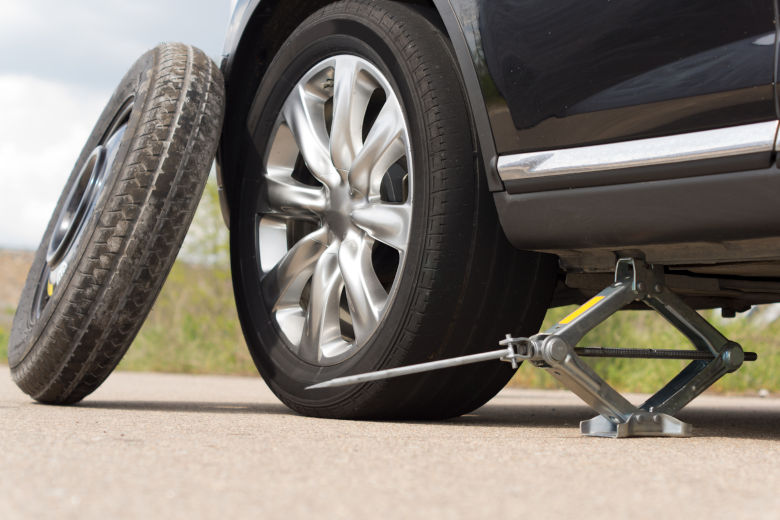
This is the simplest type of jack, and also one of the oldest styles. Many vehicles come with a basic scissor jack included with the spare tire. (Before buying a new one, you may want to check to see if you already own one!)
As the name suggests, a scissor jack is comprised of two interconnecting scissor mechanisms. There’s a base for resting on at the bottom, and a lifting saddle at the top. Running through the middle of the jack, and connecting the two sides through their respective hinges, is a long threaded screw. Turning the screw either opens or closes the two scissor joints thereby raising or lowering the saddle.
Between uses, a scissor jack folds up nice and compact, and they’re a piece of cake to store. They’re incredibly lightweight, and you can cart one about in your trunk or storage box with ease. They are very simple to use and there’s next to no maintenance required aside from just keeping them clean.
Pros
Cons
Why you might want a scissor jack
Who should consider other options
A scissor jack is a great, no-frills choice for an automotive jack. If you appreciate the simplicity and want a lightweight jack on hand for those rare times when you really need one, this is an excellent option for you.
For more information check out our complete buyer’s guide to the best scissor jacks available today!
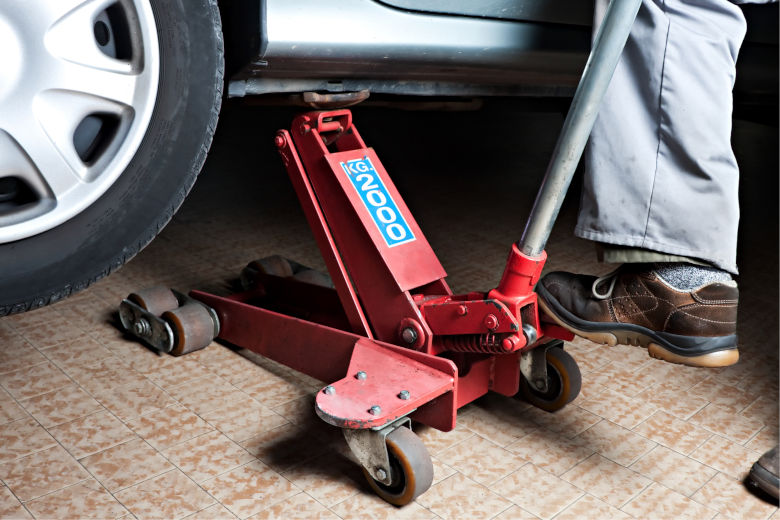
If you watch car racing, or TV shows or videos about vehicle repairs, you’ve seen a floor jack. It looks kind of like a skateboard with a long handle sticking out on an angle from one end.
They’re great in garages because they roll around on four wheels with ease. It takes no time at all to get them in position, and once there, the long handle makes raising and lowering a breeze.
If time is of the essence, a floor jack won’t disappoint with its rapid raising and lowering; many can lift a vehicle off the ground in less than ten pumps of the handle.
And when you’re done, they roll out of the way in an instant. All this, plus they’re short enough to fit under some of the lowest low riders out there.
Note: Check out our guide comparing bottle jacks vs floor jacks to see the pros and cons of each in more depth.
Pros
Cons
Why you might want a floor jack
Who should consider other options
There’s no denying the “cool factor” of owning a floor jack; having one gives your garage instant cred! They’re also probably the easiest jacks to use overall.
Convinced this is the one for you? Before you buy, give our buyer’s guide to the best floor jacks a read, first. It’s got all you need to know about what makes a great jack, plus our suggestions for what to buy.
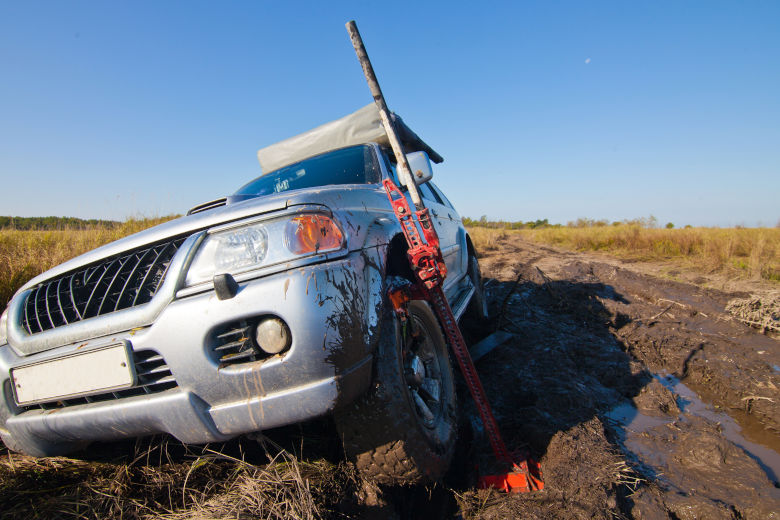
Sometimes you need to get up, like waaay up! A high-lift jack provides maximum lift and is ideal for you off-roaders and trailer owners out there. They’re more meant for emergency and recovery work than standard garage repairs, and can be a off-roaders best friend.
They’re very tall, but they’re slender, so it’s not that hard to find room for a high-lift jack in your vehicle (or even strapped to the outside). What a great thing to have for an unexpected repair when you’re in the back-country somewhere!
You have to be very careful operating a high-lift jack. They have a small footplate, so they can be unsteady. Also, there is the potential for serious injury from failing to control the handle when the jack is carrying a load.
As with all jacks, it’s essential to use a high-lift with care and caution. It’s important to note that a high-lift jack requires more strength to operate than the other three types of jack.
Hi-Lift vs. High-Lift
Although you’ll see these two terms used interchangeably, it’s worth noting that “Hi-Lift” is actually a brand of high-lift jack. So, while all Hi-Lift jacks are high-lift jacks, not all high-lift jacks are Hi-Lift jacks. All clear on that?
Pros
Cons
Why you might want a hi-lift jack
Who should consider other options
Quite simply, if you don’t go off-road, you don’t need a high-lift jack. For tall vehicles that stay on the streets and highways, get yourself a bottle jack or scissor jack with a tall maximum height.
If you think a high-lift jack is just what you need for your extreme automotive adventures, have a look at our list of the best high-lift jacks for 2023 and complete buyer’s guide.
Congratulations! You are now an expert on car jacks and are entitled to talk your friends’ ears off as you share your knowledge.
We hope we’ve managed to answer all your questions, and that you’re now ready to get down to the business of shopping for a jack of your very own.
If you know someone who could also use a little pick-me-up, go ahead and share this page with them. Better yet, tell them about the whole site and all the amazing automotive information waiting for them! Remember, the less time you take searching for info, the more time you can spend with your vehicle!
Also, you can always send us your questions, thoughts, stories, and concerns. Send us a note and we’ll do our best to address whatever you care to tell us.
Thanks for hanging out with us today. Now go put some rubber to the road – or the trail!